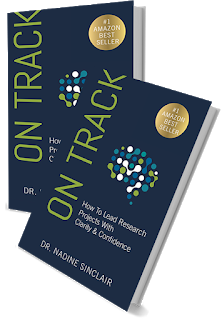How to use project management to get your PhD on track
 Today’s guest post is by Dr. Nadine Sinclair. Dr. Sinclair is one of the Founders and Managing Directors of Mind Matters, a boutique consulting firm based in Malta. Mind Matters advises large corporations on strategy and R&D topics and offers several transformative signature programs for executives and entrepreneurs. Before embarking on her entrepreneurial journey, Nadine was a management consultant with McKinsey & Company. She completed her PhD and MSc in Molecular Biology at the Max Planck Institute for Biophysical Chemistry in Germany and holds a BSc in Medical Biotechnology from the University of Abertay-Dundee in the UK. She is passionate about helping high-achievers transform their productivity, leadership style and emotional intelligence using insights from neuroscience. Fast Forward, her latest program, helps researchers to implement the project management and productivity systems described in her bestselling book On Track.
Today’s guest post is by Dr. Nadine Sinclair. Dr. Sinclair is one of the Founders and Managing Directors of Mind Matters, a boutique consulting firm based in Malta. Mind Matters advises large corporations on strategy and R&D topics and offers several transformative signature programs for executives and entrepreneurs. Before embarking on her entrepreneurial journey, Nadine was a management consultant with McKinsey & Company. She completed her PhD and MSc in Molecular Biology at the Max Planck Institute for Biophysical Chemistry in Germany and holds a BSc in Medical Biotechnology from the University of Abertay-Dundee in the UK. She is passionate about helping high-achievers transform their productivity, leadership style and emotional intelligence using insights from neuroscience. Fast Forward, her latest program, helps researchers to implement the project management and productivity systems described in her bestselling book On Track.
Project Management is not going to solve it all. It is not a magic wand that you can flick to transform a failing project into a success. However, it can help you work smarter, and as a result, be more focused and productive in what you do. It is not about cramming more hours into your overloaded days. Project management is about structuring your work in a way that allows you to make better choices, focus on what gets you closer to your goal, and reduce the day-to-day stress of working with uncertainty.
In my experience, successful project management rests on three pillars:
1. Shared Vision
Do you feel you are spinning your wheels week after week without truly making progress? Or does your project seem to have a life of its own growing and expanding in new directions with each conversation with your supervisor?
You may have missed the opportunity to build a shared vision with everybody who is involved in your project.
Starting a new project is exciting. Our motivation is at its peak, and we want to get going rather than spending days or weeks behind the desk and planning. In our haste to get started, it is tempting to skip some of the fundamental steps of managing a project.
Setting up a project starts by getting everybody involved in the project into the same room to create a tangible vision for the project and clearly define and agree on its goal using measurable criteria as goal posts. That done, we also need to consider how we will communicate throughout the project so that the project does not get side-tracked or falls behind schedule.
2. Robust Structure
Do you have many things going on at the same time, but none of them is getting closer to the finish line?
If that is you, you probably do not have a robust project structure with clear priorities, and as a result, you lack focus in your work. You are doing too many things at the same time.
To make the right choices on where to put your focus, you need to be able to see the full picture of your project first and then disaggregate it into manageable pieces. Once you can see everything that is required to achieve the project goal, you can distinguish the parts that are essential from the optional ones. This allows you to make trade-off decisions so that you spend your time in a way that will enable you to get the “biggest bang for the buck”.
3. Systems for execution
Do you have a vision and know your priorities but still do not see yourself getting anywhere despite knowing what should be done?
It sounds like you can improve your systems for execution that allow you to push your project forward consistently week after week.
You are probably familiar with Gantt charts displaying the work required to complete a project as a neat stack of sequential activities. While a Gantt chart looks good in a proposal, most research projects do not work like this. For the past two decades, agile project management has revolutionized R&D across industries. It involves short, successive cycles of planning, execution and review. Each cycle produces a partial result, and subsequent cycles build on the outcome of the previous one, thereby providing structure and flexibility at the same time.
* * * * * * * * * *
 My book On Track describes the building blocks for each of these three pillars in more detail. Follow the two main characters, Simon and Julia, over a week in the lab. Each chapter starts with a productivity challenge they are facing at work or at home, such as dealing with impromptu meetings, unresponsive collaborators, or too many tasks demanding attention. Understand how their challenges relate to typical problems people face when managing a project and balancing work and home life. Then learn a project management technique that addresses these challenges effectively and efficiently. After that, follow Simon and Julia’s challenges a second time. This time, however, knowing about project management, they handle the situation differently, and as a result, experience a different outcome. Finally, follow the next steps to get started with the techniques yourself.
My book On Track describes the building blocks for each of these three pillars in more detail. Follow the two main characters, Simon and Julia, over a week in the lab. Each chapter starts with a productivity challenge they are facing at work or at home, such as dealing with impromptu meetings, unresponsive collaborators, or too many tasks demanding attention. Understand how their challenges relate to typical problems people face when managing a project and balancing work and home life. Then learn a project management technique that addresses these challenges effectively and efficiently. After that, follow Simon and Julia’s challenges a second time. This time, however, knowing about project management, they handle the situation differently, and as a result, experience a different outcome. Finally, follow the next steps to get started with the techniques yourself.
You can download a free chapter of On Track here.
